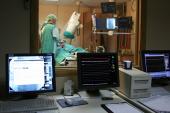Multivessel PCI May Be Less Suitable for Elderly STEMI Patients: NCDR Data
As the risk-benefit ratio changes with age, it’s important to tailor care and consider patient preference, experts say.

The potential benefits of multivessel PCI in STEMI may not extend to people older than 65 years, observational US data suggest. The analysis, using a statistical method that aims to remove unmeasured confounding, showed no difference in the risk of death, MI, and revascularization from 45 days through 1 year among patients treated not only in the infarct-related artery (IRA) but also nonculprit lesions.
This stands in contrast to results from the COMPLETE trial, which in 2019 was the first major study to demonstrate an advantage to complete revascularization. But that RCT fell on the heels of mixed data on how best to approach this clinical need.
“We still haven’t really harmonized how to take care of patients with multivessel disease and ST elevation MI,” said Eric Secemsky, MD (Beth Israel Deaconess Medical Center, Boston, MA), lead author of the new report. “I think the COMPLETE trial is helping us put that picture together, but it’s still only one well-powered study in a landscape of many other small studies that have confused practice a little bit.”
COMPLETE also showed a signal of benefit—though attenuated—among elderly patients, who made up 40% of trial participants, he and his co-authors point out in Circulation: Cardiovascular Interventions.
It’s just a good reminder for everyone to step back and discuss the preferences with the patients and use the data that we have available to make a guided decision. Eric Secemsky
Yet people age 65 and up account for much of the STEMI population in real-world practice, Secemsky told TCTMD. “We know that the risk-benefit ratio is changed for people as they progress in age. The most salient part is prognosis: the amount of time we expect them to be living is different. But also, the risks and benefits of therapy are different,” including greater bleeding risk and anatomic complexity.
“The balance of pursuing a more aggressive treatment,” he said, “is going to really need to be weighed against all the risks that come with that, and those are not necessarily captured when the average patient in a randomized trial is 60 years old and probably healthier than the general subset that we see in practice.”
So for their analysis, the investigators turned to the National Cardiovascular Data Registry (NCDR) CathPCI Registry, seeking clarity on the comparative effectiveness of multivessel PCI in Medicare patients. They learned that when the focus is on older patients with higher-risk features, “you start to find that the benefit of this invasive approach is a little bit more null,” said Secemsky.
Poonam Velagapudi, MD (University of Nebraska Medical Center, Omaha), commenting on the results for TCTMD, noted that the study provides a new perspective. “It’s real-world data in the kind of patients we’d normally see in our practice,” she said, adding that the COMPLETE participants “are not the usual suspects that we see in our STEMI volumes, really.”
Both agreed that it’s important to consider each patient’s situation—that multivessel PCI isn’t a one-size-fits-all solution.
An Effort to Reduce Confounding
In the CathPCI Registry, the researchers identified 56,332 STEMI patients older than 65 years (mean age 74.8) with Medicare-linked data who were admitted at 1,102 centers between July 2009 and December 2017. Among them, 37.7% underwent multivessel PCI of a nonculprit lesion, with 27.4% of these PCIs done during the index procedure, 30.7% as a later staged procedure but within the same hospital stay, and 41.9% after discharge but within 45 days of the index procedure; fully 74.8% had complete revascularization.
Unadjusted comparisons linked multivessel PCI to a lower incidence of death, MI, and revascularization from 45 days through 1 year (13.9% vs 18.2%; P < 0.01). It also was associated with fewer instances of major bleeding (17.5% vs 21.2; P < 0.01), a falsification endpoint that would not be expected to differ between the two group, thus “suggesting confounding,” Secemsky et al note. Multivariable-adjusted Cox regression showed the same pattern, indicating that even after these calculations, some residual confounding remained.
But when the researchers performed instrumental variable analysis (calculated based on each hospital’s proportional use of multivessel PCI), there was no link between multivessel PCI and the composite endpoint (adjusted risk difference 0.97%; 95% CI -3.52% to 1.59%). Nor was there an association seen for major bleeding (adjusted risk difference -2.54%; 95% CI -5.30% to 0.22%).
“The instrumental variable analysis is a unique statistical approach that leverages the randomness that [occurs naturally]” Secemsky said, such as changes over time or variations in practice that have nothing to do with the patients themselves. “You can use that randomness to remove concerns about many of those unmeasured variables.”
An Eye Toward RCTs
Andrew M. Goldsweig, MD (University of Nebraska Medical Center), and Vladimír Džavík, MD (Toronto General Hospital, Canada), in an accompanying editorial, say the analysis applies a “validated technique to adjust for confounders.” Citing various limitations, they question the choice of a hospital’s multivessel PCI volume as the factor to simulate randomness, given that it could be a marker of quality.
“Can advanced statistical maneuvers of the present observational study effectively refute the findings of several prior RCTs, attributing prior RCT results to unmeasured confounders? Assuming that the authors’ assumptions are valid, it is likely that the truth lies somewhere in the middle,” Goldsweig and Džavík assert. As knowledge continues to be gleaned from randomized trials and registries on how to treat older patients with STEMI, “our best guides are indeed the RCTs, with all their limitations,” they conclude.
The benefit of multivessel PCI or complete revascularization really emerges over the long term. Samir Mehta
Shamir Mehta, MD (Population Health Research Institute and McMaster University, Hamilton, Canada), principal investigator for COMPLETE, also emphasized that this analysis is observational. “And observational studies are not very good at estimating treatment effects. The main problem is that there are unmeasured confounders that are almost impossible to correct for, no matter how sophisticated the statistical analysis is. So that’s why we do randomized trials,” he commented.
Other reasons to interpret this study carefully, he said, are that it only included patients who survived at least 45 days, so they may be lower risk, and didn’t follow patients beyond 1 year. “The benefit of multivessel PCI or complete revascularization really emerges over the long term. So, although there is an effect at 1 year, it increases at 2 years then at 3 years after randomization. This may be particularly important if a patient is at lower risk,” Mehta noted.
Velagapudi brought up two procedural factors that might influence results, as well: radial access—here used in around 15% of patients, but now the topic of an ongoing RCT—and the use of intracoronary imaging to guide multivessel PCI of vulnerable plaque. Both, she said, merit further study.
‘The Patient That Is in Front of Us’
For Secemsky, the main message from their study is that treatment should be individualized, especially when it comes to age. “I think it’s just a good reminder for everyone to step back and discuss the preferences with the patients and use the data that we have available to make a guided decision,” he said.
Velagapudi said that several things can enter into the discussion, such as frailty, cognitive status, level of support, and ability to do things like return for appointments and take medications.
“All these things do matter in the elderly folks. Plus, if you look at these patients, they have more complex disease, their renal function is worse, [and] their hemoglobin is low. We take all these factors into account when we make decisions,” she said. It often makes more sense to do multivessel PCI not in the index procedure, but later on in that hospital stay or after a follow-up visit where symptoms and lesions are evaluated, Velagapudi suggested.
Despite the promise Mehta sees for multivessel PCI, he similarly stressed that it should be done right. “Patients who we select for complete revascularization should have nonculprit-lesion disease that’s readily amenable to PCI,” he said, adding that timing is also key. “[For] patients who have renal failure or are very frail and elderly, it may be better to wait prior to rushing in and doing nonculprit lesion PCI rapidly. I think those are important caveats.”
When patients are older, especially if they’re very elderly, both their wishes and those of their family are important to consider, with thought to the goals of treatment, Mehta advised. “That’s part of the art of medicine and being a physician. The randomized trials can help guide us overall one way or another, but ultimately we need to treat the patient that is in front of us.”
Caitlin E. Cox is News Editor of TCTMD and Associate Director, Editorial Content at the Cardiovascular Research Foundation. She produces the…
Read Full BioSources
Secemsky EA, Butala N, Raja A, et al. Comparative outcomes of percutaneous coronary intervention for ST-segment–elevation myocardial infarction among Medicare beneficiaries with multivessel coronary artery disease: an National Cardiovascular Data Registry Research to Practice project. Circ Cardiovasc Interv. 2021;14:e010323.
Goldsweig AM, Džavík V. Multivessel intervention in ST-segment–elevation myocardial infarction: evidence-based practice or guesswork? Circ Cardiovasc Interv. 2021;14:e011015.
Disclosures
- Secemsky reports consulting and/or serving on the speakers’ bureau/advisory boards of Bard, Cook, CSI, Janssen, Medtronic, and Philips as well as receiving grants to his institution from AstraZeneca, Bard, Boston Scientific, Cook, CSI, Medtronic, and Philips.
- Velagapudi reports no relevant conflicts of interest.
- Mehta reports that COMPLETE was funded by the Canadian Institutes of Health Research, with additional funding from Boston Scientific and AstraZeneca.
- Goldsweig is supported by a grant from the National Institute of General Medical Sciences and the UNMC Center for Heart and Vascular Research.
- Džavík is supported in part by the Brompton Group Professorship in Interventional Cardiology.





Comments